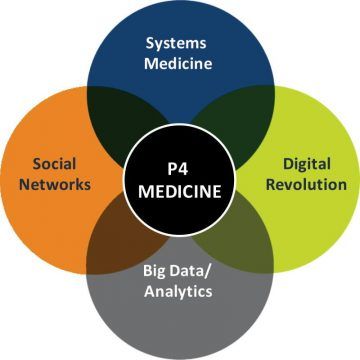Ilaria Baiardini and Enrico Heffler in Science Direct:
 The term “P4 medicine” was introduced ten years ago by Leroy Hood [1] a molecular biologist and oncologist. This approach is based on the convergence of three megatrends: the scientific and technological tools of systems medicine, the digital revolution and patients involvement in their own health thanks to social networks [2]. The four Ps (predictive, preventive, personalized, participative) [3] (Box 21.1) represent the cornerstones of a model of clinical medicine, which offers concrete opportunities to modify the healthcare paradigm [4].
The term “P4 medicine” was introduced ten years ago by Leroy Hood [1] a molecular biologist and oncologist. This approach is based on the convergence of three megatrends: the scientific and technological tools of systems medicine, the digital revolution and patients involvement in their own health thanks to social networks [2]. The four Ps (predictive, preventive, personalized, participative) [3] (Box 21.1) represent the cornerstones of a model of clinical medicine, which offers concrete opportunities to modify the healthcare paradigm [4].
While the first three Ps (predictive, preventive and personalized) [5], [6] were introduced in the early 2000, the fourth (participatory) is more recent [3]. This extension of the paradigm has been labeled by Hood and Auffrey as “a driving force for revolutionizing healthcare” [7]. The individual’s participation becomes the key to put into practice the other three aspects of P4 with each patient.
Making the patient an active, fundamental protagonist of his/her health, is an ambitious project. It requires healthcare systems to employ all strategies, resources and tools to enable patients to aware of, and responsible for, their decisions and behaviors about health.
To achieve these purposes, it is necessary that patients are engaged at each stage of the healthcare process. The promotion of participatory medicine includes a range of possibilities in which patients are asked to participate into clinical processes with their physicians.
More here.
